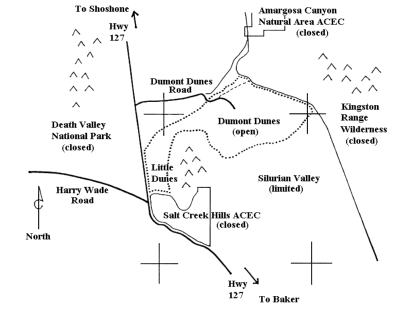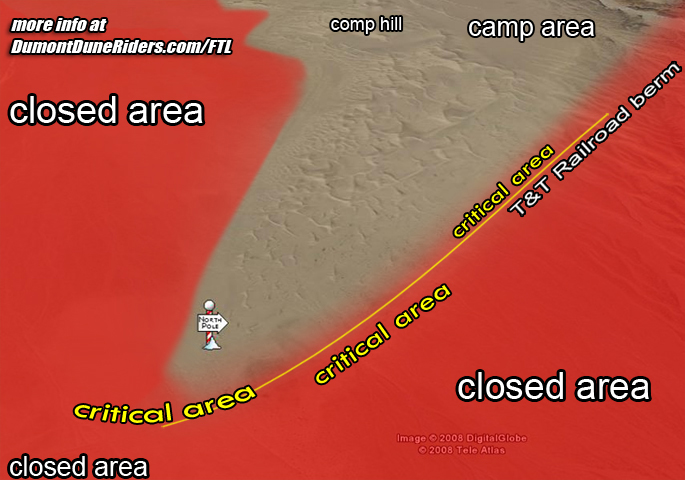
Latest
information regarding the Fringe
Toed Lizard Petition at Dumont Dunes!
July 2008
As many of you know,
the fringe toed lizard has been
under very close watch by
environmental groups and agencies.
This lizard lives at Dumont Dunes,
mostly in the surrounding areas
where vegetation and brush are
present. It is extremely important
that we, as responsible duners, work
together on this issue with a very
proactive approach to help
protect the lizard and keep Dumont
Dunes open for us OHV riders. Rather
than U.S. Fish & Wildlife Service
listing the lizard as endangered
(which could possibly result in a
permanent closure of Dumont Dunes),
the agencies are discussing the
possibility of writing and agreeing
to a conservation plan for the
lizard. This conservation plan would
protect the lizard from OHVs while
keeping the dunes open to duners of
Dumont. Working with the BLM and FWS
will be a positive step in a
direction that will support the
conservation plan.
|
The
Conservation Plan:
"One
of the very important
parts of the
conservation plan is the
degree of involvement of
the user groups (e.g.
Friends of Dumont Dunes)
by assisting with the
education of the users
with a flyer (web site
information, etc.) and
providing the
flyers/information to
users as to the areas
that may be determined
sensitive. This
area will be signed by
BLM stating that the
area beyond the sign is
sensitive. Some
post and cable fences
will be installed along
the T&T railroad berm to
prevent excursions into
the wilderness."
-William
Presch Ph.D., Director
Desert Studies,
Department Biological
Sciences, California
State University,
Fullerton.
|
|
Where
are the areas that are
critical to the fringe
toed lizard?
"Numbers indicate an
area at the southwest
corner of the dunes
extending northwest into
the Salt
Hills. The other
area is located in the
northeastern and eastern
area of the dunes on the
sand field. This
latter population
extends east to the T&T
railroad berm and
further east into the
Kingston Wilderness area
and along the north and
west side of the Valjean
Hills."
-William
Presch Ph.D., Director
Desert Studies,
Department Biological
Sciences, California
State University,
Fullerton.
|
Dumont
Dunes and
surrounding
areas
 |
Critical area
descriptions
Northeast and
east of the
dunes extending
further east of
the
Kingston
Wilderness Area:
The
Kingston
Wilderness Area
area is north
and east of
the north pole.
This is a closed
area.
Southwest corner
of the dunes
extending
northwest into
the Salt Hills:
This is an area
south of the
south pole and
rocky, sand
hills area.
(The south pole
is located
pretty much at
the boundary of
the south-most
area of the main
Dumont Dunes
open area.
Travel to the
south of this
area is
prohibited)

Click for more
information on where we are not
allowed to ride at Dumont.
|
|
Critical Area
 |
|
|
As a duner, what
can I do? I
don't want to lose
my dunes!
Our
choices are these:
(1)
Sit back, do nothing and
hope the lizard does not
get listed.
(2) Wait until it does
get listed and see what
happens.
OR
(3) voluntarily
enter into a
negotiated
conservation
agreement and, with the users support, prevent the lizard from being listed.
"One
of the very
important parts of
the conservation
plan is the degree
of involvement of
the user groups
(e.g. Friends of
Dumont Dunes) by
assisting with the
education of the
users with a flyer
(web site
information, etc.)
and providing the
flyers/information
to users as to the
areas that may be
determined
sensitive.
This area will be
signed by BLM
stating that the
area beyond the sign
is sensitive.
Some post and cable
fences will be
installed along the
T&T railroad berm to
prevent excursions
into the
wilderness."
-William Presch
Ph.D., Director
Desert Studies,
Department
Biological Sciences,
California State
University,
Fullerton.
It's
real simple then.
Riders need to ONLY
ride in the areas of
Dumont that are
designated open
areas and stay away
from the areas
described above as
those are critical
areas! Please
support the
conservation plan
and spread the word
about it to fellow
duners and friends
how we need to be
stand behind it 100%
in order for our
dunes to remain
open.
|
|
Do
conservation plans
really work?
Yes! For example:
The flat tailed
horned lizard has
been proposed for
listing in El Centro
many times, and it
does not get listed
because of the
conservation
agreement. So,
the conservation
agreements do have a
track record of
helping species to
the point that Fish
and Wildlife Service
can say they are
protected and do not
need to be listed.
|

With responsibility , OHV and
wildlife CAN co-exist!
For more information contact:
info@dumontduneriders.com
|






